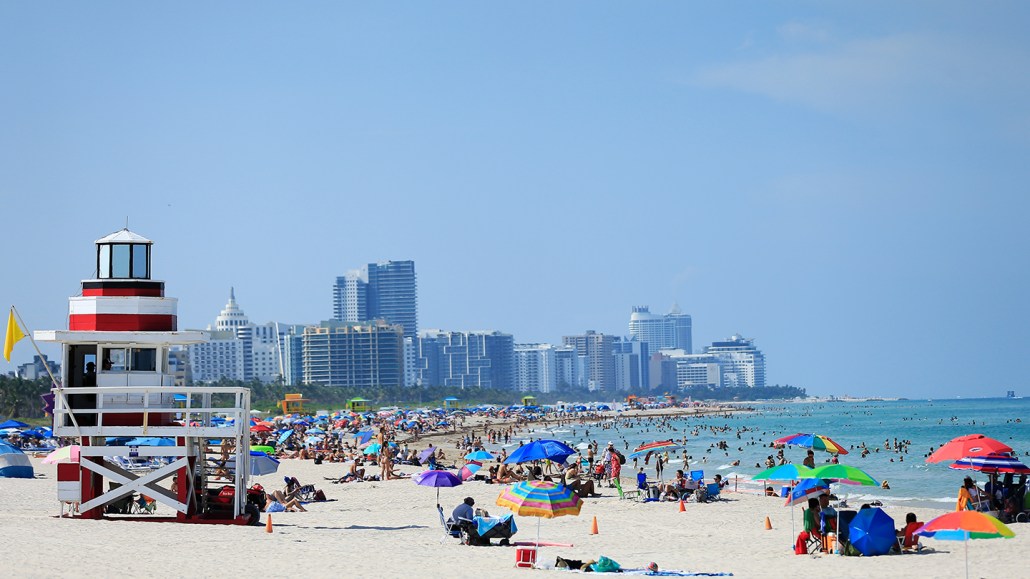Moral judgments about an activity’s COVID-19 risk can lead people astray
People see activities they condone as less risky for catching coronavirus, even if they’re not

Images of Florida beachgoers in spring of 2020 triggered a public outcry. Yet, it was thought, even then, that congregating outdoors was safer than indoors during the pandemic. New research is shedding light on why some people saw the beach as riskier than other people did.
Cliff Hawkins/Getty Images
What do you think was riskier during the pre-vaccine days of the pandemic: having your lonely parents over for dinner or going to a beach filled with dozens of strangers? Or how about going to the doctor for a prescription refill versus playing baseball at a nearby park?
When it comes to catching COVID-19, outdoor activities, in general, are safer than indoor activities (SN: 8/15/20). But if you chose the beach or baseball as riskier, you are not alone. Two new studies show that people consider activities that they think are immoral or unreasonable as riskier — even when they’re not.
“Our moral judgments change our factual judgments about the world,” says philosopher of science Cailin O’Connor of the University of California, Irvine. Accounting for moral and other biases in public health messaging is vital to combatting the spread of infectious disease, she says.
It’s well-established that people rely on emotions and beliefs to make decisions (SN: 5/14/20). These mental shortcuts, or heuristics, tend to take precedence during periods of uncertainty, as the right decision can be far from clear.
O’Connor became interested in studying the link between bias and risk perception after pictures of Floridians flocking to the beach caused an outcry in spring of 2020. “Why was the beach such a target of public judgment?” O’Connor wondered.
She and colleagues devised hypothetical scenarios in which people were exposed to the same risk of infection with the coronavirus but had various reasons for violating social distancing guidelines. For instance, a character named Joe gets trapped in an elevator with five neighbors for 25 minutes. In one scenario, Joe is a cocaine user going out to pay his dealer, while in another he is going to help an elderly neighbor fix her broken air conditioner on a hot day.
In an online survey, 841 respondents evaluated how moral Person X’s action was on a scale from one to seven and also how risky that person’s action was on a scale from one to 10. Increasing moral judgment scores by two points (to become more immoral) increased people’s perception of risk by almost a tenth of a point, the researchers report in a study posted May 10 at PsyArXiv.org, a preprint server. The study has not yet been reviewed by other scientists.
The team found a similar link when social distancing violations were seen as intentional rather than accidental. That belief could filter into this current moment, O’Connor says. It might be that people think that if another person intentionally didn’t get vaccinated, he or she is at higher risk than if a person couldn’t get vaccinated, she says. That false belief bodes poorly for those still waiting for a vaccine, such as little kids.
These effects are small but potentially consequential, says study coauthor Daniel Relihan, a psychologist at UC Irvine. For instance, such biases can appear in social media feeds, such as when social distance violations are presented as morally right and therefore relatively safe. Repeat exposure to such narratives can cloud people’s risk judgements over time, Relihan says.
In a similar study, published December 2020 at PsyArXiv.org, behavioral scientist Shane Timmons and colleagues evaluated the link between the perceived reasonableness of an action and people’s perception of COVID-19 risk. In that study, 800 online participants rated how reasonable/risky it was for Person X in a short vignette to violate social distancing guidelines when he or she had a pressing need, such as a doctor’s appointment or debilitating loneliness. A 50-point sliding scale ran from “not at all risky/reasonable” to “extremely risky/completely unreasonable.”
The researchers found when a given medical or mental health risk went from low to high — such as from a minor health complaint that could be addressed online to a potentially serious complaint requiring an in-person consultation — the perceived risk of infection decreased four points, even though the actual risk of getting COVID-19 hadn’t changed.
That four-point drop, says Timmons, of the Economic and Social Research Institute in Dublin, “equates to the change in risk people associate with going to a gathering of 15 people compared to a gathering of five or six people.”
People might be relying on their feelings to guide their actions — known as the “affect heuristic,” both teams of researchers suggest. For instance, a person who loves skiing will perceive the sport as less risky than a person who hates the sport, O’Connor says. Or perhaps, people are calling upon “just world” beliefs, the idea that good things happen to good people and vice versa.
Behavioral scientists largely agree that this research should inform public health. But sorting out how to incorporate this knowledge into a public health campaign requires further research, says psychologist Toby Wise of Caltech.
Informing a devout individual that going to a crowded place of worship during a pandemic is as risky as going to a crowded bar, for example, could backfire if people see government authorities as lacking sensitivity, Wise says. “We don’t necessarily know that we can modify these [behaviors] just through public health messaging.”
Sign up for our newsletter
We summarize the week's scientific breakthroughs every Thursday.







